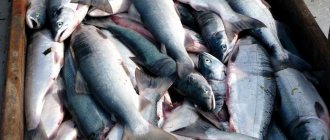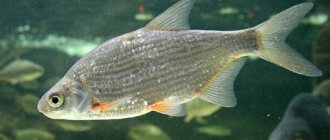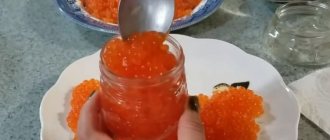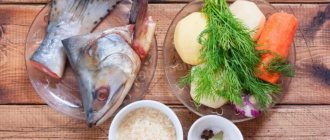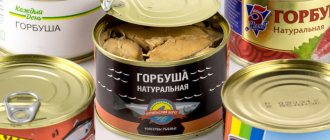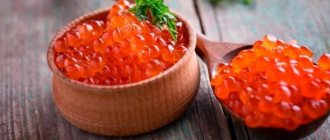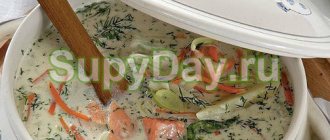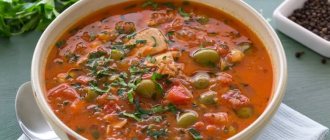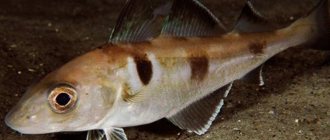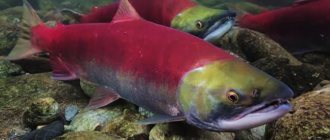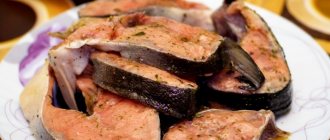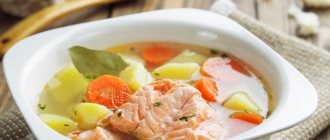Description
Pink salmon is a fish whose size does not exceed 60 cm and weighs 2 kg.
Among other species of the salmon family, pink salmon is considered the smallest. The fish looks different depending on where it is found. If in the ocean, then the body of the fish is light blue with a silvery tint. If the Far Eastern pink salmon lives in rivers, it is much lighter, with a yellowish belly and a gray back. What is noteworthy is that at the end of spawning, males develop a hump on their back, this is how you can distinguish a female pink salmon from a male. The fish tastes somewhat like trout and salmon. However, the meat part of pink salmon is dry and not very fatty.
Pink salmon - interesting features of a bright representative of salmon fish
with other salmon fish
Fishing is always great, especially if the exciting process ends with a long-awaited catch. Going for valuable trophies, both professional fishermen and amateurs dream of catching one of the most common representatives of the salmon family - pink salmon. What does pink salmon fish look like, how do the seasons affect it, when does pink salmon spawn, and what kind of gear should be used to return with the desired prey?
Appearance of pink salmon, difference from similar varieties of fish
Of the entire huge family, it is the fish of this species that is the smallest representative in size - it rarely grows more than 40 cm. The weight is also not impressive - it does not exceed 2-5 kg, but there is information that a successful fisherman caught a trophy specimen weighing 12 kg. You can meet the sea beauty not only in salt waters - not so long ago it was released into freshwater lakes, where it successfully took root.
The color varies depending on the location: while the fish is in the cold waters of the ocean, it has a gray tint with a blue tint. After being sent to spawn, which usually occurs in nearby rivers, it becomes lighter. The belly color is white, but when pink salmon migrate to fresh waters, it turns yellowish. The scales are very small and can be easily removed.
The fins are short, and there is also a “fatty” fin, which is rare for this species of fish. The head is slightly elongated, ending in a wide mouth. The description can end with a distinctive feature, which gave rise to the name. Pink salmon received it thanks to males - they, unlike females, have a large hump on their backs. Interestingly, the hump begins to grow only after being sent to spawn, in fresh river waters.
The predator's characteristics are similar to those of other salmonids, but there are a few differences. Pink salmon are often compared to chum salmon, another popular and numerous member of the family. What is the difference between chum salmon and pink salmon? Main differences:
- size (chum salmon is larger);
- coloring;
- caviar size (in pink salmon it is smaller);
- habits of the fry (chum salmon babies immediately go to the ocean after birth, while pink salmon’s young remain in river reservoirs until they grow up);
- Both chum salmon and pink salmon have beneficial properties, but differ in taste (pink salmon meat is tougher, with more calories).
Another distinguishing feature is that due to the prevalence of the fish, its cost is much lower than other varieties, despite the fact that pink salmon and salmon are the same family.
Pink salmon is an inhabitant of the depths of the Pacific or Arctic Ocean. The family goes to the rivers to spawn. Both in fresh reservoirs and in salt waters, it tries to stay near the surface, avoiding great depths and holes.
Photo 1. Pink salmon go to rivers to spawn.
The diet of the valuable family consists of fry, young small fish, and crustaceans. Since fish grow quickly, they need a lot of food, so pink salmon go hunting at any time of the day. Thanks to this feature, even a novice fisherman can successfully catch a predator.
Peculiarities of predator behavior in different seasons of the year
Photo 2. In wedding attire.
Pink salmon is a fish that spends most of its life in migration. In winter and autumn it prefers to stay in sea waters. At the age of two years, it goes to spawn, which occurs in the month of August (in Russia, the time of spawning may vary - in Kamchatka it begins in July, in Sakhalin - in June). During a long journey, females and males lose caution, feed heavily, and become easy prey for fishermen and animals eagerly awaiting a school of fish at the mouths of rivers.
Having reached their goal, the fish prepare to lay eggs. The female digs a small hole with her fins, after fertilization lays eggs in it, and then, together with the male, covers the nest with sand and stones.
It takes about three months for the fry to appear, but young fish are in no hurry to go to salty bodies of water. Only with the arrival of spring (by this period pink salmon grow up to 3 cm) do the fry migrate in large schools to the sea. The path is long and difficult - most river and sea inhabitants hunt young fish. Until next year, pink salmon feed heavily, after which they return along the already familiar path to breed and die.
Catching pink salmon: when to go hunting for a valuable predator, and what gear is best to use
You can catch pink salmon in the river only before spawning (it is found there from spring to mid-summer), and it is easy to catch both with a spinning rod and a regular float rod. The bait is usually red caviar, rolled into a tight rope. When it comes to catching predators, a spinner is used, preferably in a bright color. It reacts poorly to spinners, preferring to swim past.
The preferred color that representatives of the salmon family actively go for is bright blue, purple, and orange.
The peculiarity of the bite of males is that the bite is fast, sometimes almost not felt. After hooking, there are few jerks - often only 1-2. Pink salmon may jump out of the water several times, but this rarely happens. It is much more difficult to catch a female; once hooked, she begins to rush around wildly, often breaking down.
During spawning, it is impossible to catch a predator with a fishing rod or spinning rod - the fish completely stops feeding and does not respond to bait. You can use nets or a tee (the so-called cat), but this type of fishing is prohibited by law and is punishable as poaching.
Photo 3. Fly fishing is a catchy method for pink salmon.
Pink salmon caught before spawning is of great value - the meat is elastic and has excellent taste. After spawning, the fish becomes loose and tough; it can only be used in cooking as minced meat. It is rarely caught at this time.
Catching pink salmon is an entertaining process, and with the onset of summer, hundreds of professionals and amateurs go hunting for valuable prey. It doesn’t matter whether luck smiled, because the most important thing in fishing is to relax your soul and body, enjoying every minute.
IT IS IMPORTANT TO KNOW! Fishermen caught 25 kg of fish using the Fish XXL ! Read more.
Pink salmon - interesting features of a bright representative of salmon fish
with other salmon fish
Fishing is always great, especially if the exciting process ends with a long-awaited catch. Going for valuable trophies, both professional fishermen and amateurs dream of catching one of the most common representatives of the salmon family - pink salmon. What does pink salmon fish look like, how do the seasons affect it, when does pink salmon spawn, and what kind of gear should be used to return with the desired prey?
A group of fishermen revealed the name of the secret bait during interrogation.
Category: regional news.
Appearance of pink salmon, difference from similar varieties of fish
Of the entire huge family, it is the fish of this species that is the smallest representative in size - it rarely grows more than 40 cm. The weight is also not impressive - it does not exceed 2-5 kg, but there is information that a successful fisherman caught a trophy specimen weighing 12 kg. You can meet the sea beauty not only in salt waters - not so long ago it was released into freshwater lakes, where it successfully took root.
The color varies depending on the location: while the fish is in the cold waters of the ocean, it has a gray tint with a blue tint. After being sent to spawn, which usually occurs in nearby rivers, it becomes lighter. The belly color is white, but when pink salmon migrate to fresh waters, it turns yellowish. The scales are very small and can be easily removed.
The difference between sockeye salmon, coho salmon, masu salmon and other salmon
Pink salmon belongs to the salmon family, which also includes chum salmon, salmon, trout and others. The fish described is sometimes called salmon. Therefore, it is necessary to understand what the difference is between these types of fish.
Pink salmon is not similar to chum salmon in the following indicators:
- Weight. The difference reaches six kilograms. Chum salmon weighs up to 8 kg, and pink salmon – 2 kg.
- Fillet color. Chum salmon has pinkish meat, and pink salmon has reddish flesh.
- Scales. © https://ydoo.info/product/gorbusha.html Pink salmon have a lightish belly, and the scales are small and covered with dark spots on the side of the ridge and on the tail. Chum salmon do not have spots. In addition, her scales are large and silvery.
Pink salmon differs from salmon not only in external characteristics, but also in its use in cooking. Pink salmon is a Pacific fish, and salmon is an Atlantic fish. In addition, only male pink salmon are capable of growing a hump during spawning. Salmon is longer than pink salmon. Its length reaches 1.5 m, while pink salmon is only 60 cm. When making sushi and snacks, chefs give preference to salmon, since its meat is dense. Pink salmon is tough and not very juicy, and also not as tasty as salmon.
Pink salmon differs from sima salmon:
- fillet fat content (pink salmon is not as fatty as salmon);
- body color (pink salmon have small spots, while masu salmon have large spots);
- the size of the eyes (in the masu salmon they are small, almost like beads, in the pink salmon they are large);
- scales (on the sima it comes off more easily and does not stick to your hands).
Trout has fattier meat than pink salmon. In addition, the weight of the first fish reaches 20 kg, and the second - only 2 kg. Pink salmon have a hump, but trout do not.
The sizes of coho salmon and pink salmon are almost the same, but the color is different. The first has a predominant green tint on the back and head, and silver on the side and belly. Coho salmon also have transverse stripes. But the main difference is that pink salmon’s meat is not as juicy as coho salmon’s.
The difference between sockeye salmon and pink salmon lies not only in size (the former is longer), but also in the quality of meat. The flesh of sockeye salmon is very fatty, and it contains much more useful substances than pink salmon.
Useful properties of fish
The beneficial properties of pink salmon are associated with the presence of a colossal amount of vitamins and minerals in the chemical composition of the fish. In addition, the product contains omega-3 fatty acids that can lower cholesterol, normalize blood pressure, and strengthen nerve cells.
It is worth noting that the product contains vitamin D, which takes part in the formation of bone tissue and prevents the risk of rickets or osteoporosis.
The protein contained in fish is absorbed by the human body quite quickly, unlike meat. Eating fish also has a beneficial effect on the functioning of the heart and blood vessels. Since pink salmon does not contain sugar or carbohydrates, it is acceptable to eat if you have diabetes.
Although fish is very filling, it is a low-calorie product; its calorie content per 100 grams is 140 kcal. Nutritional value (BJU-balance): proteins - 20.5 g, fats - 6.5 g, carbohydrates - 0 g. Therefore, such fish can be eaten if you follow dietary and nutritional nutrition.
Note! Under the influence of heat treatment, some of the beneficial substances evaporate from the fish.
Pink salmon will also benefit pregnant women, but only if eaten in moderation. The daily norm is 150 g. Use no more than 3 times every 7 days.
It is allowed to eat fish while breastfeeding, but not earlier than 4 months after the birth of the baby. In this case, the product must be boiled or steamed. At first, you should eat only a small piece (about 30 g). If the child feels comfortable, you can continue to eat fish. This dish should appear on the table no more than 2 times a week. You can eat no more than 400 g in 7 days.
Children can eat pink salmon only after reaching 1 year of age. If the baby shows signs of allergies, then such a product can only be eaten after 3 years.
In addition to meat, caviar, which contains not only easily digestible proteins, but also a whole complex of amino acids and omega-3 and 6 fatty acids, as well as vitamins and minerals, will be beneficial for human health. It is recommended to eat the product to strengthen the immune system, improve brain function and accelerate skin regeneration processes. You also need to eat the product to normalize the functioning of the central nervous system, normalize cholesterol levels and improve metabolism.
Taste and beneficial properties of pink salmon
Pink salmon is a prominent representative of the salmon family of fish species, which are distinguished by their unique taste and the presence of a whole bunch of useful substances and vitamins. Pink salmon meat has a pink-red color, but is somewhat dry compared to the meat of other representatives of this family. Pink salmon meat is not suitable for frying or baking in foil. It is better to cook it in the oven with various sauces, resulting in pink salmon meat that is tender and juicy.
Pink salmon is considered a very healthy fish and is recommended for consumption even by pregnant women. This is due to the fact that pink salmon meat contains a full range of microelements that ensure the formation of the human skeleton.
Pink salmon meat contains useful acids, such as Omega-3, which help maintain sugar levels in the human body. Pink salmon meat also contains other acids that have a positive effect on the human body. It is very important that pink salmon meat contains iodine, which contributes to the normal functioning of the thyroid gland, central nervous system and improved memory.
If you regularly consume pink salmon meat, you can protect yourself from the following:
- Hypertension.
- Asthma.
- Allergies.
- Diabetes.
- Arthritis.
- Stomach ulcers.
- Obesity.
Vitamins
Pink salmon meat is rich in the following vitamins:
- Vitamin A.
- Vitamin C.
- Vitamin B1.
- Vitamin B2.
- Vitamin RR.
Microelements
Fish is in great demand due to the presence of such useful components as:
- Yoda.
- Phosphorus.
- Calcium.
- Magnesium.
- Sodium.
- Cobalt.
- Chlorine.
- Zinc.
- Potassium.
- Nickel.
- Gland.
- Manganese.
Calorie content
Pink salmon meat is considered a dietary product because it contains a small amount of calories. There are no carbohydrates in the meat, and the fat ratio is only 40%. 100 grams of pure meat contains 150-170 kcal.
Harm and contraindications
It is harmful to eat pink salmon for those who are intolerant to the product. It is also not recommended to eat fish if the consumption of foods containing phosphorus and iodine is prohibited.
It is contraindicated to eat pink salmon if you have a stomach ulcer, liver disease, or problems with the gastrointestinal tract.
Salted fish roe can also cause harm to the body if you eat it in very large quantities. As a result, excess fluid is retained in the body, which causes swelling. It is worth noting that caviar contains cholesterol, which negatively affects the functioning of the heart and blood vessels.
In addition, eating pink salmon caviar is contraindicated for the following diseases:
- atherosclerosis;
- obesity;
- problems with cardiovascular activity.
Smoked and salted products accumulate harmful substances that negatively affect human health. It also contains sodium, which can retain fluid in the body, resulting in swelling and increased blood pressure. Therefore, the product is not recommended for those who suffer from hypertension, swelling and kidney disease.
Canned fish will be harmful if it is spoiled or prepared in violation of the technology. Also, you should not eat the product if you have liver disease, since it contains cholesterol.
It is not recommended to eat boiled pink salmon in excessive quantities, or if you are intolerant to the product.
Spawning pink salmon are also harmful to the body. After spawning, the fish loses a large amount of nutrients, which also affects the taste of the product. Therefore, it is not advisable to eat fish.
How to select and store?
To choose the right fish, you need to decide what it is for and what kind of dish you want to cook from it. A carcass with a head is required only for stuffing fish or for cooking soup. If the goal is different, it is best to take a carcass without a head.
What you need to pay attention to when choosing fresh pink salmon:
- Appearance of gills. In a fresh product they are red. If the gills are mucus-covered and green, the fish is bad.
- Eyes. In a quality product, they are transparent and without a cloudy film.
- Abdomen color. It should be pinkish. If the abdominal cavity is yellow, it means the product has spoiled.
- Condition of the skin. It should be undamaged, clean and tightly adjacent to the meat.
- Tail. It should not be dried out or weathered.
If you need to buy fillets, you should examine the color of the meat, which should be pink. If the fillet is white, it means the product is frozen. As a result, the fish dish will be dry, and there is no way to fix this.
To select a female pink salmon with caviar, lightly press on the abdominal cavity. If the seal is palpable, it means there is caviar inside. You also need to look at the hole where the eggs come from. It should be pinkish and larger than other fish.
Pink salmon should be stored either in the refrigerator or in the freezer. The product must be wrapped in parchment. Shelf life in the refrigerator is no more than 3 days. Can be stored frozen for 3 weeks.
Price range
Pink salmon is the cheapest and most accessible of the red fish varieties. It is bred on numerous farms, so in every store you can find an abundance of all kinds of options. It is sold fresh, frozen, smoked and salted. The price of a fresh-frozen headless individual per kg is about 250 rubles. The cost of an uneviscerated carcass will be slightly higher, but you should not overpay. Finding pink salmon with caviar is quite difficult.
Chum salmon is much more expensive and cannot be found everywhere. The fish reproduce in their natural environment and are not artificially bred. Hence the high cost of the product. The cost of a fresh frozen carcass without a head is about 450 rubles. You can purchase the head, ridge and other parts separately for preparing various dishes. Here the price varies depending on the part of the fish.
When making a purchase, you should consider not only the cost, but also the appearance of the fish. The surface must be clean and shiny. The gills should be red or pink. The scales and fins fit smoothly to the skin. The color of the fillet should be even and the meat should be dense. Try it and decide which is tastier than pink salmon or chum salmon.
Yandex pictures
Use in cooking
Pink salmon has found wide application in cooking around the world. Fish can be placed on the holiday table as an independent dish or used in various recipes to create mouth-watering delicacies.
What is noteworthy is that pink salmon can not only be fried, stewed or baked in an oven, but also boiled, smoked, fried over a fire, on a grill, pickled and even salted.
Often the product is added to hot dishes (for example, soups with millet, fish soup), and is also served as a main course along with a side dish of porridge (rice, buckwheat, pearl barley), beans, pasta, pasta or mashed potatoes. If you bake fish with mushrooms in the oven, then it is better to serve it with some kind of vegetable or puff salad (for example, Mimosa or with crab sticks).
The fish also goes well with other types of fish (for example, mackerel), vegetables (broccoli, zucchini, cabbage, potatoes, onions, corn, carrots, cucumber, spinach, sweet peppers, tomatoes, garlic), herbs, processed cheese, pineapples, apples and lemon, especially if they are baked with pink salmon meat.
As a filling, pink salmon is placed in tartlets, pies made from puff pastry and yeast dough, pies, lavash rolls, pies, rolls, omelettes, casseroles (you can also add pollock), dumplings, heh, quiche.
You can make pate, soufflé, balyk, jellied fish, steak, rillette from fish, or grind the flesh into minced meat for cutlets.
If you want to cook pink salmon shish kebab at a barbecue, you can marinate the fish fillet in any marinade, even kefir will do.
When baking whole fish, sauces such as creamy, sour cream, tomato, soy, garlic and bechamel are suitable, and you can also use mayonnaise.
If pink salmon milt is used for cooking, it is better to fry it in egg batter, milk, flour or breadcrumbs.
Canned pink salmon in oil is added to various snacks and used to make sandwiches. Tesha fish (strips cut from the abdominal area) are mainly salted or smoked and used as an appetizer.
How to clean and cut?
In order to clean and fillet pink salmon, you need to prepare a small vegetable knife, but only a sharp one, so as not to damage the fish meat. If you want, you can wear gloves on your hands.
Step-by-step instructions for cutting pink salmon:
- Removing scales. Initially, the surface of the fish is cleared of scales. You need to move from the tail to the head. Once the surface is cleaned, the fish should be thoroughly rinsed under running water to remove any stuck-on scales.
- Removing the entrails. To quickly gut a fish, you will need to cut the belly and remove the internal organs. To prevent the fillet from becoming bitter, you need to remove the film from the surface of the carcass. To do this, you will need to make a small incision along the length of the vertebral region, cut the film and remove the blood clots. After the entire procedure, the carcass should be washed thoroughly.
- Removal of fins, bones and tail. The fish is placed on the board, the tail, head and fins that are located on the stomach and back are cut off. Then the carcass is cut along the entire length of the abdomen. To separate the fish from the bone, you will need to insert a small knife between the rib bones and the meat layer, which is located near the ridge. In this case, the sharp side of the device should be directed towards the spinal region. Now you need to gradually move the knife towards the edge of the abdominal area, removing the bones. To clear the tail area of bones, you should get rid of the ridge and divide the carcass into a couple of parts. As a result, it turns out that one half of the fish will be cleaned, and the other half will contain bones, which are removed in the same way as described above.
- Cleaning the fillet from the skin. The skin is picked up from the wide part of the carcass and torn off to the tail. If suddenly the meat is peeled off along with the skin, the latter must be carefully removed with a knife. Upon completion of the procedure, the fillet is cut into portions and cooked. If the meat needs to be baked in the oven, you will need to remove only the large bones without touching the small ones, since they will soften under the influence of heat treatment and will be easier to remove from the fish.
To clean a frozen product, you need to transfer it from the freezer to the refrigerator and leave it until the next day. The fish will calmly defrost - and it can be cut in exactly the same way as described above. If there is no time to wait, the product is defrosted at room temperature within 2 hours.
If you have caviar, you can use it to prepare some dish. However, the product must first be cleared of film. This can be done in two ways:
- To do this, you will need to remove the caviar from the fish carcass and wash it under water. Several small cuts need to be made on the film. Now you need to prepare a sieve with large holes through which the eggs will pass. Transfer the product to a sieve and press lightly. Thanks to this method, the eggs will come out through the sieve, and the film will remain on the surface of the dish.
- Boil water in a container, and then dip the caviar into the liquid. Now you need to mix the caviar with a whisk so that the film collects on the whisk. Afterwards, pour out the liquid and salt the caviar.
If you need to prepare fish for salting, the product should be thoroughly rinsed and dipped in salted water for a quarter of an hour. Halve the carcass, removing the skin and backbone. Then the fillet is cut into pieces and salted.
When cutting fish for frying in batter, the product should be slightly frozen. You will need to cut off the tail with fins and head, and wash the carcass. Then use a knife to make a line along the length of the ridge to the tail. Holding the edges of the cuts, remove the skin and divide the workpiece into two parts. Free one of them from the bones, and to remove the bones from the other half, you need to hold the spine with one hand and pull out the bones with the other.
How to defrost?
You can defrost pink salmon using several proven methods. Simply remove the fish from the freezer, place it in a deep container and place it at the very bottom of the refrigerator until the next day.
You can also defrost the product at room temperature. This will take approximately 1 hour. Afterwards, pink salmon should be rinsed with water. Fish fillets are defrosted in the same way as whole fish.
In addition, you can defrost it with cold water. Pack the product into bags, tie tightly and place in a container with cold liquid. Then place this container under a stream of cold water. After 1.5 hours the fish will be defrosted.
Never defrost fish using a microwave or hot water.
Cooking methods
There are a lot of ways to prepare pink salmon. However, it is worth considering a few useful tips regarding cooking fish:
- You only need to take a fresh carcass.
- Black pepper, salt, and olive oil are suitable as spices.
- Cooking time in the oven is 40 minutes. If you overcook the meat, it will become dry. Cook for no more than 15 minutes, and fry for 20 minutes.
- It is advisable to bake fish in foil, a sleeve or a special bag. Also available in pots.
- The fish will be tender if kept in lemon for half an hour.
- To stuff pink salmon, it is better to take mushrooms or vegetables. Before baking, the fish must be poured with some sauce or sprinkled with cheese.
- In order for the cooked fillet to be juicy enough, it must first be dipped in any marinade.
At home, pink salmon can be subjected to any type of cooking. Dishes with it turn out incredibly tasty and aromatic.
| Cooking option | Description |
| In an air fryer, electric grill | The fish is cut, washed and cut into pieces that are convenient to eat. Then the workpieces must be placed on the lower grill of the device, lubricated with oil. The temperature inside the device is 250 degrees, baking time is 40 minutes. |
| In the oven | The fillet is cut into pieces and mixed with spices. You also need to make a sauce for the fish in which it will be baked. First, a little sauce is laid out on a baking sheet, then the fish and then the sauce again. The temperature in the oven should not exceed 180 degrees. |
| In a saucepan | First, vegetables are cooked with spices. After 10 minutes from the start of cooking, pieces of fish are laid out. Cooking lasts another 15-20 minutes. |
| In the smokehouse | You can cook fish either hot or cold. The product needs to be cut up (the scales do not need to be removed) and washed. First, the fish is marinated and then sent to the smokehouse for 40 minutes. Afterwards the product is ventilated and placed in the refrigerator. You can store smoked food for no more than 14 days. |
| In the microwave | The purified product is marinated and placed in the bowl of the device, and then placed in the microwave. You need to set the maximum power. Cook for 15 minutes. |
| In a slow cooker | First, the cleaned carcass pieces are fried in the “Baking” mode for 10 minutes on each side. Then the preparations are poured with sauce and cooked in the same mode, but only for 30 minutes. |
| In a steamer | Pink salmon is prepared in the upper compartment, and water is poured into the lower one. The total cooking time is 15 minutes. Raw fish can be seasoned with spices. |
| Dried fish | The fillet is cut into pieces, transferred to a dry marinade and sent to the refrigerator for a day. Drying fish must be done in a dehydrator at a temperature of 45 degrees. Cooking time – 24 hours. The finished product can be stored in an airtight container in the refrigerator. Dried fish will be an excellent snack for beer. |
| Pickling | Initially, the carcass is cut, divided into two rugs and washed under water. After this, you can proceed to salting the fish. The fillet parts are thoroughly rubbed with spices, then wrapped in a bag and put in the refrigerator for a day. Some people also add cognac to the brine for salting; this will make pink salmon taste like salmon. |
| Salted fish | The cleaned carcass is cut into pieces and placed in a jar along with seasonings and oil. In this case, the layers need to be alternated: fish - spices with oil - fish. Afterwards, the container must be closed and refrigerated for 5 hours. |
| In a frying pan | The fish needs to be cut, washed, cut and marinated. After this, the meat is coated in batter and fried until the surface is golden brown. Each side takes approximately 3 minutes. After frying, pink salmon can be stewed by adding a little water and spices with vegetables to the container. This will take about 20 minutes. |
If pink salmon is very salty, it can be soaked in cold water (the liquid must be changed periodically), milk (soaked for 4 hours) or lemon juice and water in a ratio of 1:3, respectively.
What to replace it with?
Pink salmon can be replaced by trout, chum salmon or salmon. Also, the described product can be replaced with another red fish from the salmon family.
To prepare the salad, canned pink salmon can be replaced with either saury or tuna in oil.
When preparing tartlets, it is permissible to replace the smoked product with lightly salted fish.
Pink salmon is not only tasty, but also a very healthy fish for the body, of course, if you eat it in moderation. In addition, such a universal fish is suitable for preparing any dish, giving the product an impeccable taste and aroma.
Process of cutting pink salmon
This process is quite labor-intensive, especially if it is carried out for the first time. When cutting up pink salmon, you should not throw away the head, tail and fins. You can cook delicious and very healthy fish soup from them.
What tools are needed?
The following tools are used for cutting fish:
- Kitchen board.
- A fairly sharp knife.
- Grater.
- Peeler.
- Disposable bags.
How to prepare fish?
If the fish is freshly frozen, then first of all it should be thawed. In order for the product to be of high quality, this process should not be forced. It can be thawed in the refrigerator or in a bowl of cold water. After this, you need to wash it thoroughly to get rid of mucus. Finally, it is advisable to blot the carcass with a paper towel, which will remove excess moisture. A carcass prepared in this way will not slip out of your hands.
How to remove scales?
It can be cleaned immediately in the sink or on a cutting board. With one hand the fish is held by the tail, and with the other the scales are removed using a knife or grater: whichever is more convenient for you.
The scales are cleaned from the tail to the head. A similar operation is carried out on both sides. Work should be done carefully and slowly so that you don’t have to collect scales all over the kitchen.
The fish gets rid of scales from all sides, including on the belly and in the fin area. Upon completion of cleaning, pink salmon should be rinsed under running water. Then the fish's head, tail and fins are cut off. After this, the fish is gutted and the entrails are removed. The black film, if there is one, is also removed. Finally, the fish is thoroughly washed again, both inside and out.
How to cut fillet?
This is perhaps the most crucial moment. First, you will need a sharp knife. Secondly, you need to use it to pry the skin of the fish, and then make a deep cut along the ridge from head to tail. After this, with the same sharp knife, the fish meat is separated from the bones on both one side and the other.
